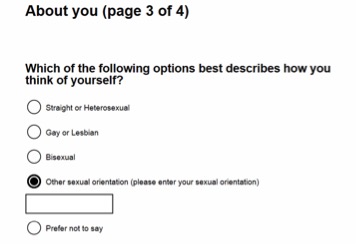#AceWeek: (Not) the only ace in the village?
Ace Lead Robin Tamblyn discusses Ace Week.

“Maybe this will be the year they finally acknowledge that asexual people exist,” I thought to myself as I opened up the 2020 Civil Service People Survey. I self-identify as a heteroromantic asexual woman, as I am attracted romantically but not sexually to men, and have spent several years campaigning to have an “asexual” option added to the sexual orientation options in this survey (previously the only ones listed have been “Heterosexual/straight,” “Gay or lesbian,” “Bisexual,” “Other” or “Prefer not to say.”)
Before the internet age, few people had even heard of the term “asexual” in relation to human sexuality. Our community has grown in strength since the late 1990s, with many ace-related sites now online. The most prolific and well-known of these sites is the Asexual Visibility and Education Network (AVEN), which was founded in 2001 by David Jay and now has over 70,000 members. The asexual community has also adopted its own Pride symbols, such the asexual flag, which consists of four horizontal stripes: black, grey, white, and purple. The black stripe represents asexuality, the grey stripe represents the grey area between sexual and asexual, the white stripe represents sexuality, and the purple stripe represents community. Some asexual people also wear a black ring on the middle finger to symbolise their orientation (mine has a dove in the centre and I sometimes wear it during Asexual Awareness Week, which is observed every year in late October).
Asexual people face similar issues to the bisexual community, who sometimes experience discrimination from both gay and straight peers, as well as being under-represented by the media. Ace identities are constantly erased or belittled in popular culture – the canonically-ace character Jughead from the “Archie” comics was heterosexualised in the TV adaptation Riverdale, while an ace couple in the TV show House were revealed to be “not really” asexual, as one partner had a medical condition which affected his sex drive and the other was “pretending” to be ace to keep him happy. As David Jay noted about this offensive portrayal: “The episode encourages viewers to meet asexuality with skepticism rather than acceptance, to probe asexual people for causes of our “condition” rather than to accept us as a part of the natural spectrum of human sexual diversity.”
From a personal perspective, I am fortunate not to have experienced any such discrimination on the basis of my sexuality (aphobia) at work (sadly, dating as an asexual person is a different story, as the view of asexuality as something that is “fake” or can be “fixed” or “cured” is still prevalent). There are still many misconceptions out there with regard to asexuality though: when I discussed possible future wedding plans with one colleague, he asked: “But how can you get married if you are asexual?”
The Civil Service have taken several steps to increase ace inclusion over the past few years. In 2018, the Civil Service Rainbow Alliance changed its name to the Civil Service LGBT+ Network, to demonstrate that this network is for everyone with a minority sexual orientation, gender identity or sex characteristics. They also run events across the country that are open and welcoming to asexual people via BiSpace, an initiative run by bi+ civil servants for bi+ civil servants, which includes an online forum to discuss ace-related issues.
So, to get back to the current People Survey… having reached the third page of the “About you” section, the “Other” option was still present, but now there was an additional “free text” box to enter my sexual orientation. So for the first time, I am able to record my asexuality on the staff survey. While we still have a long way to go to attain full visibility, progress has been made and I am still hopeful that in the near future it will no longer be necessary to tick the “other” box at all. #AcesAreNotOther!
Want to find out more about asexuality? Read the Civil Service LGBT+ Network’s Asexuality Fact Sheet